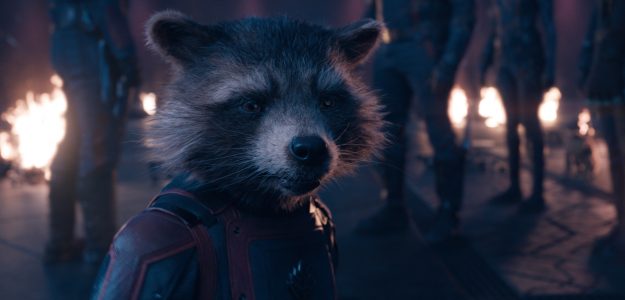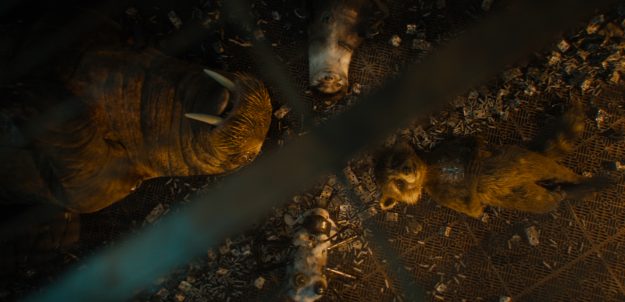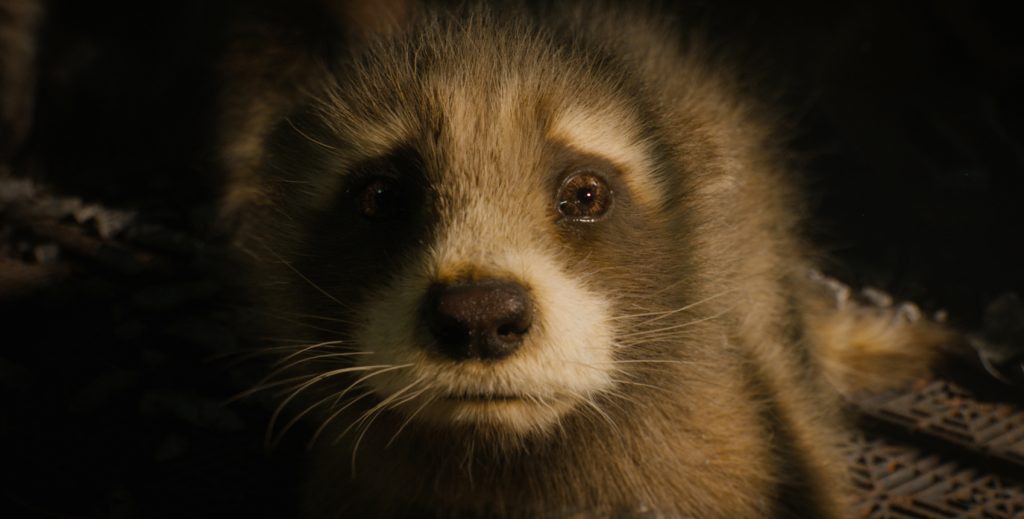Guardians of the Galaxy Vol. 3 initially caught my eye because of how much I enjoyed the humor-filled interstellar action of the first two films in the series. And while I knew beforehand that this movie would center more on Rocket—the anthropomorphic raccoon who is both a Guardian and former mercenary—I came away pleasantly taken aback by its explicit engagement with animal rights and liberation. In a Marvel franchise characterized by irreverence and flashy galactic battles, the third installment carries the unexpected and bodhisattva-like message to save all beings, even the nonhuman ones.
The movie opens with a cage full of baby raccoons in a dark, dingy lab. One kit is pulled from the cage for experimentation, and the scene then transitions out of the past to present-day Rocket Raccoon, revealing metal implants and scars all over his body. Rocket is critically injured shortly thereafter but cannot receive treatment due to a proprietary “kill switch” wired into his heart by the bioengineering company that created him. While his fellow Guardians race to unlock the code that would allow them to treat Rocket’s wounds and prevent his death, the movie fills in his backstory as an escaped laboratory experiment for the High Evolutionary, a scientist seeking to perfect the universe. The High Evolutionary created a planet called Counter-Earth with the aim of populating it with peaceful and intelligent humanoid inhabitants, but he first needs to recapture Rocket so he can harvest his highly intelligent brain and perfect his latest batch of specimens. And even though a perfect society is sought, viewers are pushed to consider if it’s worth the cost of countless animal lives discarded along the way as failed experiments.
Like some of the other main characters—such as Gamora and Drax—Rocket’s past is filled with suffering and pain. Yet unlike the others, Rocket’s story also highlights concerns surrounding nonviolence and compassion for all beings, beckoning viewers to consider their positions regarding the treatment of those who aren’t human and how they might work toward saving them. Buddhist ethics regarding the treatment of nonhuman animals generally follows the same perspective concerning human animals, grounded in the first of the five precepts—don’t take life, don’t cause life to be taken, and don’t encourage or facilitate the taking of life—and ahimsa (nonviolence), often phrased as “do no harm.” In his chapter on animal ethics in The Oxford Handbook of Buddhist Ethics, Paul Waldau indicates that committing to the first precept amounts to “a conscious effort to refrain from intentional[ly] killing any living being” and that it “requires one to notice, and then take seriously, one’s nonhuman neighbors.” That’s certainly a unique imperative to consider in a series predicated on the protection and guarding of the galaxy’s inhabitants—since many of them aren’t human—and the focus on caged animals that demand the same level of compassion as humanlike species illustrates this well.

Ever since Rocket’s initial escape from the lab many years ago—during which he witnessed the murder of his friends and fellow test subjects—he shut out his painful past and even distanced himself from identifying with his own kind, becoming enraged if anyone called him a raccoon. It’s not until the end of the movie that Rocket decides to stop running from the suffering of his past so he can rescue others. After the Guardians board the High Evolutionary’s ship, he tells them to “save all the higher life-forms” while he heads to the control room. As he’s wandering through the ship, he finds himself face-to-face with cages of animals waiting to be experimented on—including a cage filled with baby raccoons that is all too reminiscent of his own imprisonment years earlier. In Zen master Thich Nhat Hanh’s book on Buddhist ethics, For a Future to Be Possible, he explains that it’s through suffering that compassion is born. “Our real enemy is forgetfulness,” he states, so we must stay in touch with that suffering and nourish an awareness of it so compassion can grow, which is exactly what stirs Rocket to action in that scene and shifts his perspective: a palpable reminder of the similarly grisly treatment he had pushed away. With tears in his eyes, Rocket uses the same key card he created for his own escape—having held on to it his whole life—and frees the raccoons and other animals along with the latest Counter-Earth candidates: children of a species that look and act very human.
Once all the children are off the ship and the High Evolutionary is defeated, Gamora tells the Guardians that they need to go, but Rocket replies, “We have to save them.” Peter Quill, the group’s leader, tells him they already have “all the kids on board,” to which Rocket replies, “No, Pete. The rest of them.” When all the additional animals start jumping onto the Guardians’ ship, one of the crew members assisting with the rescue remarks, “I thought we were limiting ourselves to the higher life-forms.” “Me too,” Quill replies, suggesting he still isn’t convinced that their rescue is warranted. Even Rocket’s fellow Guardians, who flew across the galaxy to try to save him, fail to extend compassion to the other nonhuman animals aboard the ship—and Rocket comes to the realization only after he encounters the room full of cages. In many ways, Rocket’s journey symbolizes the bodhisattva vow to save all beings and the cultivation of bodhicitta (arising of the awakening mind)—which is foundational along that path—as self-concern gives way to selfless concern for others. And his newfound dedication to taking seriously that shared, interrelated preference to avoid suffering and experience joy noticeably aligns with the outlook of biocentric ethicists: the recognition of inherent worth of all beings, of which humans are merely one species among many.

Resonating with Thich Nhat Hanh’s remarks above, the movie also points to the need to maintain a close connection to the suffering that exists in the world if we are to work toward transforming it. Animal testing isn’t public for a reason. It’s characteristically inhumane, and seeing it take place can be harrowing. But that’s also exactly why organizations like People for the Ethical Treatment of Animals (PETA), Animal Liberation Front (ALF), and Last Chance for Animals (LCA) include footage of their raids or undercover operations in their campaigns and rescue announcements—to not only demonstrate what’s actually taking place but also to appeal to the emotive response of a public seeing what discreetly, if not secretly, takes place in the industries structuring our societies.
After the young Rocket is first taken and experimented on, he’s returned to a cage with the top of his scalp exposed, implying that his brain had been subjected to some sort of manipulation. It’s at that moment when viewers hear his strained, first spoken word: “huurrttss.” This scene of a raccoon with a stitched and shaven scalp shaking in pain is eerily similar to one of the more famous rescues from the early days of documented raids: Britches, the stump-tailed macaque monkey whose eyes were sewn shut at birth and affixed to a device that “let out a constant screeching sound” as part of a sleep deprivation study. Although Guardians of the Galaxy Vol. 3 is a work of science fiction, the use-value relationship between scientist and specimen continues every day, and the movie brings us closer to that very real suffering, violence, and taking of life. And it’s important to reiterate that Rocket’s shift from wanting to just save the “higher life-forms” to setting out to save “the rest of them” doesn’t occur until he stumbles into an all-too-familiar cage-filled room on the High Evolutionary’s ship and sees the trapped animals. But simply feeling compassion isn’t quite enough, Thich Nhat Hanh adds. “We have to learn to express it” through understanding and insight.
Such an imperative might call for a mindful release of laboratory animals suffering in the confines of their cells. But we need to eliminate the possibility of even getting to that stage to begin with—and I think Rocket would agree. In a flashback scene showing the members of his test group coming up with names for themselves, viewers finally get an explanation for “Rocket”: “Someday, I’m gonna make great machines that fly, and me and my friends are gonna go flying together into the forever and beautiful sky; Lylla, and Teefs, and Floor, and me…Rocket.”
As Guardians of the Galaxy Vol. 3 brings us closer to the suffering of nonhuman beings—and animals that are experimented on—to remind us that they too deserve compassion and freedom from suffering, Rocket piloting those he cares about through a forever and beautiful sky becomes a great analogy for the bodhisattva-like resemblance suggested above. But until that requisite freedom is fully recognized—until we notice and take seriously our nonhuman neighbors in a way that the first precept entails—the world will continue to be built upon the violation of those who will never catch a glimpse of anything as endless or magnificent as what Rocket dreamed.
Thank you for subscribing to Tricycle! As a nonprofit, we depend on readers like you to keep Buddhist teachings and practices widely available.
